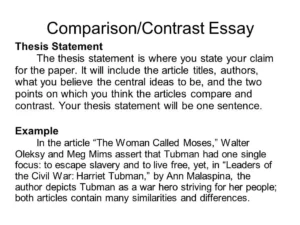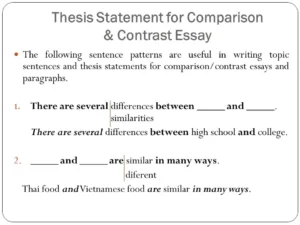Struggling with the intricacies of compare and contrast essays and grappling with the creation of that essential thesis statement in the right thesis format? You’re not alone. Crafting a compare and contrast essay can be an intimidating endeavor, and at its heart is the vital component of the thesis statement. Your thesis statement dictates the course of your entire paper, and it’s paramount to get it right.
In this blog, we’ve tailored a solution to address this very issue. Whether you’re a student striving for excellence in your assignments or a writer aiming to hone your skills, our aim is to provide you with a clear and comprehensive formula for success in crafting a compelling thesis statement for your compare-and-contrast essay. We’ll delve into the significance of a well-structured thesis, break down its essential components, and provide practical examples, ensuring that you not only understand the art but also master it. Let’s embark on this journey together and explore the path to writing a successful compare-and-contrast thesis.
What is a Compare and Contrast Thesis?

A compare and contrast thesis is a central statement in an essay that highlights the key similarities and differences between two or more subjects. It serves as a roadmap for the reader, outlining the direction and purpose of the essay. Typically, a strong compare and contrast thesis includes the specific subjects being compared and contrasted, as well as the main point or argument being made.
For example, if you’re comparing the literary works of William Shakespeare and Christopher Marlowe, your thesis might look like this: “In this essay, I will compare and contrast the writing styles of William Shakespeare and Christopher Marlowe to demonstrate how both playwrights contributed to the development of English drama, with a focus on their use of poetic devices, character development, and thematic exploration.”
This thesis not only identifies the subjects (Shakespeare and Marlowe) but also presents the main points of comparison (writing styles and contributions to English drama), setting the stage for the rest of the essay.
The Power of a Well-Crafted Thesis Statement
Before we delve into the formula for success, it’s crucial to understand the significance of a well-crafted thesis statement. In a compare and contrast essay, your thesis statement plays several pivotal roles:
- Guiding Your Reader: A clear and concise thesis statement informs your readers about the purpose and direction of your essay. It acts as a roadmap, ensuring your readers know what to expect.
- Maintaining Focus: Your thesis statement keeps your essay on track, preventing it from drifting into unrelated topics or arguments. It acts as a tether, keeping your analysis tightly focused.
- Providing Structure: Your thesis statement sets the structural framework for your entire essay. It dictates the order of your arguments and ensures your essay flows logically.
- Offering Evaluation: It gives your readers a basis to assess the validity of your arguments and the coherence of your analysis throughout the essay.
The Components of a Strong Compare and Contrast Thesis Statement

An effective thesis statement for a compare and contrast essay consists of several key components:
- Significance: In addition to identifying the subjects and presenting a controlling idea, your thesis statement should convey why the comparison is significant or what the purpose of the comparison is. Explain to your readers why it’s worth their time to explore the similarities and differences between the subjects. This element adds depth to your thesis and makes it clear that your comparison serves a meaningful purpose, such as highlighting important insights, drawing connections, or shedding light on a specific issue or question.
- Scope: Specify the scope of your comparison. Make it clear what aspects of the subjects you will be comparing and contrasting. This can be as broad or as specific as your essay requires. For instance, if you’re comparing two historical figures, mention whether you will be focusing on their personal lives, political accomplishments, or impact on society. Defining the scope helps in setting boundaries for your analysis and ensuring your thesis is clear and focused.
- Thesis Type: There are different types of compare and contrast essays, and your thesis statement can vary depending on the approach you choose. Common types include point-by-point comparison, subject-by-subject comparison, and a combination of both. Mention the type of comparison you’ll be using in your thesis statement to provide clarity to your readers.
- Clear Language: Use clear and concise language in your thesis statement. Avoid vague or ambiguous terms. Make sure that your readers can easily understand the subjects, the central idea, and the key points you’ll be discussing. Clarity is essential for a strong thesis statement.
- Specificity: Be specific in your thesis statement. Avoid broad and generalized statements. Instead, offer precise details about the subjects and the aspects you’ll be comparing. Specificity helps your readers understand the depth of your analysis and what to expect in the essay.
- Reflective Essay Structure: Your thesis statement should align with the structure of your essay. If you plan to discuss several key points in a specific order, make sure your thesis statement reflects this structure. It should act as a preview of the essay’s organization.
- Argumentative and Thought-Provoking: A strong thesis statement should be arguable, meaning it should invite discussion and analysis. It’s not just a statement of fact but rather a position that can be debated or explored further. Encourage your readers to engage with your thesis and consider different perspectives on the comparison.
Tips for Writing a Good Compare and Contrast Thesis
Writing a strong compare-and-contrast thesis is crucial for an effective essay. Here are some tips to help you craft a good thesis statement for your compare-and-contrast essay:
-
Be Specific:
Clearly identify the subjects you are comparing and contrasting. Specificity provides a clear focus for your thesis and the rest of your essay.
Example: “In this essay, I will compare and contrast the characters of Jane Eyre and Elizabeth Bennet.” -
State Your Main Point:
Express a concise and arguable main point about the subjects’ similarities and differences. Your thesis should answer the question, “What is the main message you want to convey in your essay?”
Example: “While both Jane Eyre and Elizabeth Bennet are strong female characters in classic literature, their approaches to challenges and societal norms differ significantly.” -
Highlight Key Points:
Provide a preview of the main criteria or aspects you’ll examine when comparing and contrasting the subjects. These key points give your readers a roadmap for your essay.
Example: “I will delve into their backgrounds, relationships, and personal growth to highlight the distinctions in their characters.” -
Use Clear Language:
Keep your thesis statement clear and concise. Avoid vague or overly complex language, as your thesis should communicate your main message straightforwardly.
Example: “This essay will compare and contrast the economic policies of two different administrations to illustrate their impact on job growth and inflation rates.”

-
Make It Arguable:
A strong thesis statement should present an argument or perspective that can be debated. Avoid making statements that are self-evident or purely descriptive.
Example: “While chocolate and vanilla are popular ice cream flavors, chocolate is clearly superior in terms of taste and versatility.” -
Revise and Refine:
Don’t be afraid to revise your thesis as you develop your essay. It’s common for your understanding of the topic to evolve as you research and write.
-
Consider the Significance:
Your thesis should convey why the comparison is meaningful or what insights it offers. Explain the relevance of comparing the chosen subjects. Example: “By comparing the environmental policies of Country A and Country B, we can better understand the potential impact of different approaches on reducing carbon emissions.”
-
Balance Similarities and Differences:
Ensure that your thesis acknowledges both the commonalities and disparities between the subjects. A well-rounded comparison explores both aspects.
Example: “This essay will examine the shared cultural influences and distinctive artistic styles of Picasso and Matisse, highlighting the unique contributions of each artist to modern art.” -
Use Parallel Structure:
Maintain consistency in the structure of your thesis when presenting the compared elements. This helps in creating a clear and organized thesis statement.
Example: “Both the political ideologies of conservatism and liberalism offer unique solutions to societal issues, but their approaches to government intervention and individual rights differ significantly.” -
Address the “So What?” Question:
Anticipate and answer the question of why your comparison matters or what conclusions can be drawn from it. Provide a glimpse of the implications or significance.
Example: “Comparing the educational systems of two countries not only deepens our understanding of their approaches to learning but also offers insights into the potential for global educational reform.” -
Tailor Your Thesis to Your Essay Structure:
Adapt your thesis statement to align with the structure of your essay. If you plan to compare and contrast within separate paragraphs, make that clear in your thesis.
Example: “This essay will first analyze the historical context and then the literary techniques of two celebrated poems, ‘The Waste Land’ and ‘The Love Song of J. Alfred Prufrock.'”
A well-crafted thesis statement might look like this:
“In this essay, I will compare and contrast ‘1984’ by George Orwell and ‘Brave New World’ by Aldous Huxley to explore the themes of dystopia, government control, and individual freedom. I will delve into the distinct methods these authors employ to portray the consequences of totalitarian regimes and the suppression of individuality.”
In this example, the thesis statement clearly identifies the subjects, presents a main idea concerning the themes and government control, and offers a preview of the key points of analysis.
Conclusion
Crafting a compelling thesis statement is the first step towards success in your compare and contrast essay. Whether you’re a student, a professional writer, or in need of a dedicated thesis writer, understanding the crucial elements of a thesis statement is essential. By implementing SEO optimization techniques, you can create a blog that not only attracts readers but also offers valuable information. A well-structured and informative thesis statement not only enhances your essay but also boosts your blog’s search engine visibility. This blog serves as your comprehensive guide to mastering the art of crafting the perfect thesis statement for your essay, ensuring that your content is both informative and easily discoverable.
Whether you’re a student looking to excel in your academics or a writer seeking to hone your skills, this blog provides the formula for success in crafting a compelling compare and contrast thesis. We’ve explored the importance of a strong thesis, broken down its essential components, and even delved into the world of SEO optimization to ensure your blog reaches a wide and appreciative audience. With this knowledge, you’re well on your way to becoming a master of the compare and contrast thesis.


